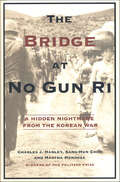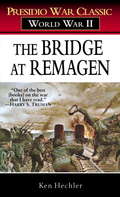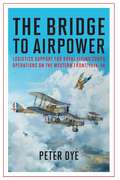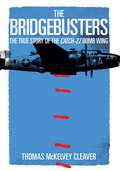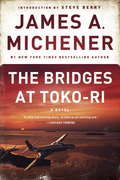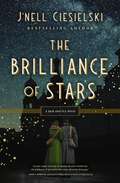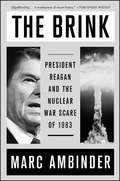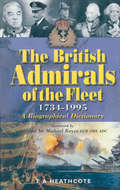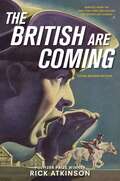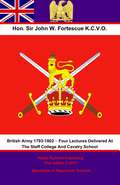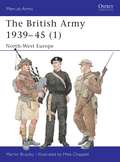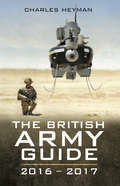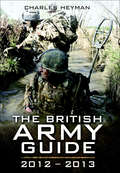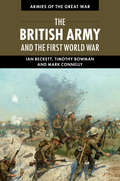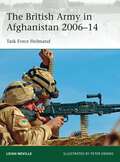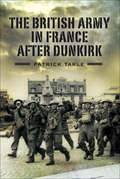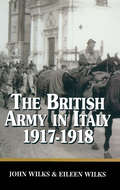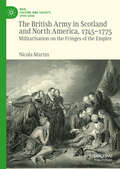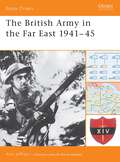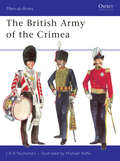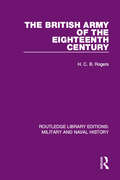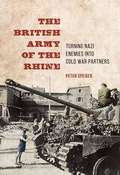- Table View
- List View
The Bridge at No Gun Ri: A Hidden Nightmare from the Korean War
by Charles J. Hanley Martha Mendoza Sang-hun ChoeThe untold human story of a massacre of Korean civilians by American soldiers in the early days of the Korean War, by the Pulitzer Prize-winning journalists who uncovered it.In the fall of 1999, a team of Associated Press investigative reporters broke the news that U.S. troops had massacred a large group of South Korean civilians early in the Korean War. On the eve of that pivotal war's 50th anniversary, their reports brought to light a story that had been suppressed for decades, confirming allegations the U.S. military had sought to dismiss. It made headlines around the world. In The Bridge at No Gun Ri, the team tells the larger, human story behind the incident through the eyes of the people who survived it: on the American side, the green recruits of the "good time" U.S. occupation army in Japan made up of teenagers who viewed unarmed farmers as enemies and generals who had never led men into battle; on the Korean side, the peasant families forced to flee their ancestral village caught between the invading North Koreans and the U.S. Army. The narrative looks at victims both Korean and American; at the ordinary lives and high-level decisions that led to the fatal encounter; at the terror of the three-day slaughter; at the memories and ghosts that forever haunted the survivors. The story of No Gun Ri also illuminates the larger story of the Korean War-also known as the Forgotten War-and how an arbitrary decision to divide the country in 1945 led to the first armed conflict of the Cold War.
The Bridge at Remagen: A Story of World War II (Presidio War Classic Ser.)
by Ken HechlerIt was a stunning strategic victory of World War II–and one of the most fantastic breaks for the Allies. On March 7, 1945, a small group of American infantrymen, engineers, and tank crews secured the Ludendorff Bridge that crossed the Rhine. The successful mission saved thousands of American lives and spearheaded the invasion of Nazi Germany. The Bridge at Remagen is the detailed narrative of this surprising but crucial military action, one that stunned the German army. It is also the moving story of men who did not consider themselves heroes, but who performed magnificently under fire. In this amazing true story, Ken Hechler gives you the hour-by-hour account of brilliant military daring, human courage, and almost incredible luck that profoundly changed the course of the war. From the Paperback edition.
The Bridge to Airpower
by Peter DyeThe Bridge to Air Power describes how the development of the air weapon on the Western Front during the First World War required a radical and unprecedented change in the way that national resources were employed to exploit a technological opportunity. By examining the performance of the Royal Flying Corps, and its successor the Royal Air Force - the world’s first independent air service - it explains how logistic competence was the precondition for air superiority and the 'modern style of warfare’ - in the form of indirect, predicted artillery fire. The Royal Flying Corps was led by a new breed of soldier-technocrats, who combined military values, managerial competence and business skills. The outcome was a new style of warfare that wove together industrial mobilization, national resources and operational art. The Royal Flying Corps’ logistic staffs, led by Brigadier-General Robert Brooke-Popham, demonstrated considerable agility in meeting the demands of three-dimensional warfare. Providing adequate numbers of frontline aircraft to maintain air operations in support of the British Expeditionary Force, required substantial numbers of skilled and semi-skilled personnel, located largely beyond the battle zone, operating at a continuously high tempo while coping with rapid technological change and high wastage. These elements formed a complex, dynamic and integrated network that was also partly self-sustaining, in the form of salvage and repair, with the ability to compensate for shortfalls in aircraft and aero-engine production as well as unpredicted demand. This was a time critical process that required careful planning to balance quantity, quality, resilience and efficiency for maximum military effect while coping with unpredictable weather, operational uncertainty and tactical innovation. The Royal Flying Corps’ logistic system was modern both in its needs and in the processes developed to meet these needs. A variety of logistic techniques were pioneered including, supply chain integration, strategic warehousing, velocity management, postponement and make-to-order, new product introduction, international sourcing, hybrid and reverse logistics. In creating the foundation for three-dimensional warfare, logistics became the bridge between the nation’s economy and air power. The principles developed on the Western Front to achieve air superiority provided the foundation for Royal Air Force logistic and operational success in the Second World War as well as anticipating the management practices that underpin today’s global supply chain.
The Bridgebusters: The True Story of the Catch-22 Bomb Wing
by Thomas Mckelvey Cleaver"He had decided to live forever, or die in the attempt." - Catch-22 <P><P>The men of the 57th Bomb Wing flew out of Corsica during World War II and bombed vital bridges throughout Italy to sabotage German supply routes. Their missions were dangerous and never-ending. <P><P>One bombardier in the wing was a young New Yorker named Joseph Heller, who would later turn his experience into the classic 1961 war novel Catch-22. <P><P>Now aviation historian Thomas McKelvey Cleaver takes a closer look at the real-life men of the 57th, whose camaraderie in the face of death inspired the raucous cast of heroes and antiheros in Catch-22.
The Bridges at Toko-Ri
by James A. Michener Steve BerryIn one of his beloved early bestsellers, Pulitzer Prize-winning author James A. Michener crafts a tale of the American men who fought the Korean War, detailing their exploits in the air as well as their lives on the ground. Young and innocent, they arrive in a place they have barely ever heard of, on a ship massive enough to carry planes and helicopters. Trained as professionals, they prepare for the rituals of war that countless men before them have endured, and face the same fears. They are American fighter pilots. Together they face an enemy they do not understand, knowing their only hope for survival is to win. BONUS: This edition includes an excerpt from James A. Michener's Poland. Praise for The Bridges at Toko-Ri "A vivid and moving story, as well as an exciting one . . . The humanity of the people is deeply felt."--Chicago Tribune "The Banshees screaming over Korea, the perilous landings on an aircraft carrier deck 'bouncing around like a derelict rowboat,' a helicopter rescue from the freezing waters . . . all are stirringly rendered."--The Denver Post "Michener's best . . . a story of action, ideas, and civilization's responsibilities."--Saturday Review
The Brigade
by Howard Blum Inc. Hardscrabble EntertainmentNovember 1944. The British government finally agrees to send a brigade of 5,000 Jewish volunteers from Palestine to Europe to fight the German army. But when the war ends and the soldiers witness firsthand the horrors their people have suffered in the concentration camps, the men launch a brutal and calculating campaign of vengeance, forming secret squads to identify, locate, and kill Nazi officers in hiding. Their own ferocity threatens to overwhelm them until a fortuitous encounter with an orphaned girl sets the men on a course of action--rescuing Jewish war orphans and transporting them to Palestine--that will not only change their lives but also help create a nation and forever alter the course of world history.
The Brigade: A True Story of War and Salvation
by Howard BlumNovember 1944. The British government finally agrees to send a brigade of 5,000 Jewish volunteers from Palestine to Europe to fight the German army. But when the war ends and the soldiers witness firsthand the horrors their people have suffered in the concentration camps, the men launch a brutal and calculating campaign of vengeance, forming secret squads to identify, locate, and kill Nazi officers in hiding. Their own ferocity threatens to overwhelm them until a fortuitous encounter with an orphaned girl sets the men on a course of action--rescuing Jewish war orphans and transporting them to Palestine--that will not only change their lives but also help create a nation and forever alter the course of world history.
The Brilliance of Stars (A Jack and Ivy Novel #1)
by J'nell CiesielskiAmid the chaos of the Great War, two elite assassins learn precisely how dangerous it is to have something—or someone—worth losing.Washington, DC, 1914. Ivy Olwen knows how to survive on the streets without two coins to rub together. Then destiny thrusts her into the nest of a covert agency of assassins sworn to drive back the world&’s darkness, and she acquires a new set of lethal skills. Her education—from explosives to etiquette, sharpshooting to sabotage—is as far reaching as the organization&’s missions. But it&’s the hours she spends among the towering bookshelves in the library and stargazing on the roof with Agent Jack Vale that make her heart fly.Jack knew plenty of hardship before the agency refined his rough edges, transforming him into the man who never misses. But he didn&’t know the feeling of home until Ivy entered his world. Now Jack&’s heart drums with a singular purpose: he will fight for her, fight alongside her. No matter the cost.When the pair is sent on a seemingly simple mission to take down Russia&’s newest and most dangerous arms dealer—a soulless man using the Great War as an opportunity to further his own depraved agenda—they discover that no amount of training could have prepared them for a manhunt that takes them across the frozen tundra, to the Crimean Peninsula, and along the Trans-Siberian Railway . . . only to discover that there is evil in the world they will never understand.The first book of an epic duology from bestselling author J&’nell Ciesielski, The Brilliance of Stars incorporates her signature blend of thrilling adventure, glamorous espionage, and sweeping romance.Historical romance set during World War IBook length: approximately 116,000 wordsThe first Jack and Ivy novel; book two, To Free the Stars—coming August 2023Includes map of Europe 1917 and discussion questions for book clubs
The Brink: President Reagan and the Nuclear War Scare of 1983
by Marc Ambinder&“An informative and often enthralling book…in the appealing style of Tom Clancy&” (Kirkus Reviews) about the 1983 war game that triggered a tense, brittle period of nuclear brinkmanship between the United States and the former Soviet Union.What happened in 1983 to make the Soviet Union so afraid of a potential nuclear strike from the United States that they sent mobile ICBMs (intercontinental ballistic missiles) into the field, placing them on a three-minute alert Marc Ambinder explains the anxious period between the United States and the Soviet Union from 1982 to 1984, with the &“Able Archer &’83&” war game at the center of the tension. With astonishing and clarifying new details, he recounts the scary series of the close encounters that tested the limits of ordinary humans and powerful leaders alike. Ambinder provides a comprehensive and chilling account of the nuclear command and control process, from intelligence warnings to the composition of the nuclear codes themselves. And he affords glimpses into the secret world of a preemptive electronic attack that scared the Soviet Union into action. Ambinder&’s account reads like a thriller, recounting the spy-versus-spy games that kept both countries—and the world—in check. From geopolitics in Moscow and Washington, to sweat-caked soldiers fighting in the trenches of the Cold War, to high-stakes war games across NATO and the Warsaw Pact, &“Ambinder&’s account of a serious threat of global annihilation…is spellbinding…a masterpiece of recent history&” (Publishers Weekly, starred review). The Brink serves as the definitive intelligence, nuclear, and national security history of one of the most precarious times in recent memory and &“shows the consequences of nuclear buildups, sometimes-careless language, and nervous leaders. Now, more than ever, those consequences matter&” (USA TODAY).
The British Admirals of the Fleet, 1734–1995: A Biographical Dictionary
by T. A. HeathcoteA companion volume to the same author's "The British Field Marshals 1736–1997", this book outlines the lives of the 115 officers who held the rank of Admiral of the Fleet in the Royal Navy from 1734, when it took its modern form, to 1995, when the last one was appointed. Each entry gives details of the dates of the birth and death of its subjects, their careers ashore and afloat, their family backgrounds, and the ships, campaigns and combats in which they served. Each is placed clearly in its domestic or international political context. The actions recorded include major fleet battles under sail or steam, single-ship duels, encounters with pirates on the Spanish Main and up the rivers of Borneo, the suppression of the Slave Trade (for which the Navy receives little gratitude), landing parties to deal with local dictators and revolutionaries, and the services of naval brigades in China, Egypt and South Africa.
The British Are Coming: The War For America, Lexington To Princeton, 1775-1777 (The\revolution Trilogy Ser. #1)
by Rick AtkinsonHow did the United States become the country it is today? What led to its creation?Adapted from Pulitzer Prize–winner Rick Atkinson’s deeply researched and stunningly vivid The British Are Coming, the young readers edition explores these questions and so much more as it delves into the American Revolution. A collection of key battles from the beginning of the war, including Lexington and Concord and the Battle of Bunker Hill, sets the scene, telling a story of liberation fraught with contradiction and intrigue.History buffs and newcomers alike will be drawn into this fascinating, photo-illustrated account.
The British Army 1793-1802 – Four Lectures Delivered At The Staff College And Cavalry School
by Hon. Sir John William Fortescue K.C.V.O.This ebook is purpose built and is proof-read and re-type set from the original to provide an outstanding experience of reflowing text for an ebook reader. Sir John Fortescue holds an un-rivalled place among the historians of the British Army, having written the best-known and most comprehensive account of its operations from its foundations in Norman times to the first World War. He may have rivals for certain periods of warface, notable Sir Charles Oman, regarding the Peninsular War, with whom he was friends and shared research, however his breadth and depth of knowledge was unparalleled. Sir John was invited by Colonels Sir Henry Rawlinson and Julian Byng, both would go on to have distinguished careers as Army commanders in the First World War, to lecture at the Staff College and Cavalry School. Although he gave four lectures on the development of the army as a whole and the cavalry in particular, he added two additional essays on the St Lucia campaign of 1776 and the history of the transport and supply. An excellent read by a world famous authority on the subject. Original -148 pages Maps - 5 - Not Included due to their size - A3 Author - Hon. Sir John William Fortescue K.C.V.O. - (28th December 1859 - 22nd October 1933) Linked TOC.
The British Army 1939-45
by Mike Chappell Martin BrayleyThe scope of Britain's wartime Middle East Command stretched far beyond the Libyan desert where the 8th Army's most famous battles were fought - from Gibraltar and Tunisia in the west, to Iraq and Persia in the east, and from Greece south to the Gulf of Aden. In the 1940-43 period of World War II, this was the only arena where the British Army could take the ground war to the German Wehrmacht; it saw a succession of setbacks and triumphs, until spring 1945 found the 8th Army victorious in northern Italy. A summary of these campaigns is illustrated by photographs, and detailed colour plates of the wide range of uniforms worn in the varied conditions of this huge theatre of war.
The British Army Guide, 2016–2017: 2016-2017
by Charles HeymanIn 1984 the first edition of the British Army Guide was published and in September 2015 the 13th edition will be on sale. This invaluable information resource which deals with all aspects of British Army organisation, recruitment and training has been extremely popular with service personnel, the defence industry, military libraries and other groups who are interested in the British Army worldwide. Copies can be seen on desks throughout the UK Ministry of Defence and it would be fair to say that almost every foreign defence attache in London has a copy in his briefcase.Chapters include a Defence Overview; Army Organisation; International Commitments; Armour, Infantry, Artillery, Army Aviation, Engineers, Communications and Combat Service Support; Units of the Army; Recruiting and Training; Reserve Forces plus a final Miscellaneous Chapter which deals with a number of items essential to understanding How the British Army functions on a daily basis. Lavishly illustrated throughout there is no comparable publication available on the market.
The British Army Guide: 2012-2013
by Charles HeymanIn 1984 the first edition of the British Army Guide was published and in May 2011 the 12th edition will be on sale. This invaluable information resource which deals with all aspects of British Army organization, recruitment and training, has been extremely popular with service personnel, the defense industry, military libraries and other groups who are interested in the British Army worldwide. Copies can be seen on desks throughout the UK Ministry of Defense and it would be fair to say that almost every foreign defense attach in London has a copy in his briefcase. Chapters include a Defense Overview; Army Organization; International Commitments; Armor, Infantry, Artillery, Army Aviation, Engineers, Communications and Combat Service Support; Units of the Army; Recruiting and Training; Reserve Forces plus a final Miscellaneous Chapter which deals with a number of items essential to understanding How the British Army functions on a daily basis. Lavishly illustrated throughout there is no comparable publication available on the market.
The British Army and the First World War
by Mark Connelly Ian Beckett Timothy BowmanThis is a major new history of the British army during the Great War written by three leading military historians. Ian Beckett, Timothy Bowman and Mark Connelly survey operations on the Western Front and throughout the rest of the world as well as the army's social history, pre-war and wartime planning and strategy, the maintenance of discipline and morale and the lasting legacy of the First World War on the army's development. They assess the strengths and weaknesses of the army between 1914 and 1918, engaging with key debates around the adequacy of British generalship and whether or not there was a significant 'learning curve' in terms of the development of operational art during the course of the war. Their findings show how, despite limitations of initiative and innovation amongst the high command, the British army did succeed in developing the effective combined arms warfare necessary for victory in 1918.
The British Army in Afghanistan 2006-14
by Leigh NevilleFighting an elusive and dangerous enemy far from home, the British army in Afghanistan has been involved in asymmetric warfare for the best part of a decade. The eight-year series of deployments jointly known as Operation 'Herrick', alongside US and other NATO contingents within the International Security Assistance Force (ISAF) in Afghanistan, have been the longest continuous combat commitment of the British Army since World War II. Together with Operation 'Telic' in Iraq, which immediately preceded and overlapped with it, this conflict has shaped the British Army for a generation. Enemy threats have diversified and evolved, with a consequent evolution of British doctrine, tactics and equipment. This book provides a detailed analysis of those specifics within a clear, connected account of the course of the war in Helmand, operation by operation.
The British Army in France After Dunkirk
by Patrick TakleAlthough over 330,000 British and French soldiers were evacuated from the Dunkirk beaches between 26 May and 4 June, many thousands remained in France, most under French command. Churchill, now the Prime Minister, and desperate to keep the French in the War, decided to form a Second BEF made up of 51 Highland, 1st Armoured and the Beauman Divisions, reinforced from the UK by a second Corps. He also ordered vital and scarce RAF fighter squadrons to France. Had these been lost the Battle of Britain might have had a very different result. General Alan Brooke was to command the second Corps comprising the only viable formations in the UK. Realizing the hopelessness of his mission he delayed for as long as possible. Meanwhile the situation in France went from bad to worse and five units were squandered. At St Valery 800 of the 51st Highland Division surrendered after heavy fighting and being outflanked by Rommel. This is the fascinating story of a disaster that could have been so much worse had Churchill had his way.
The British Army in Italy 1917-1918
by Eileen Wilks John WilksAfter the Italian defeat at Caporetto, a Bri tish Expeditionary Force under General Plumer was despatched from France. This account describes the campaign which ende d after the victory at Vittorio Veneto over the Austrians. '
The British Army in Palestine and the 1948 War: Containment, Withdrawal and Evacuation (Israeli History, Politics and Society)
by Alon KadishFollowing the end of the Second World War, the main mission of the British Army in Palestine was to contain Jewish attacks and illegal immigration while the fate of the Mandate was being decided. This book is a record of the British Army during the final year of the Mandate and its impact on the course and outcome of the 1948 War.With the decision of the UN General Assembly on 29th November 1947 to partition Palestine and the anticipated eruption of inter-communal violence, the Army was made responsible for the maintenance of law and order throughout Palestine until the termination of the Mandate on 15th May 1948. These crucial months are considered from the point of view of the ranks of the British Army, soldiers and field commanders rather than that of generals and statesmen. It makes extensive use of memoirs, contemporary writing and private diaries, as well as archival material and regimental journals. Subjects such as regimental culture and leisure activities are explored in addition to operations and peace-keeping.The book offers an important contribution to the history of the Middle East, and readers interested in political science, the history of the British Army, military history, Palestine and Israel will find in this book a new and innovative view of the 1948 War.
The British Army in Scotland and North America, 1745-1775: Militarisation on the Fringes of the Empire (War, Culture and Society, 1750–1850)
by Nicola MartinThis book examines militarisation in Scotland and North America from the Jacobite Uprising of 1745-1746 to the outbreak of the American Revolutionary War in 1775. Employing a transatlantic, case study approach, it investigates the overarching cultural frameworks, individual circumstances, and local conditions guiding the actions and understandings of British army officers as they waged war, pacified hostile peoples, and attempted to assimilate &‘other&’ population groups within the British Empire. The process of militarisation fundamentally altered how officers viewed imperial populations and implemented empire on geographical fringes, leading to the development of a military-imperial mentality where the direct and indirect experiences of the army in Scotland were transferred and adapted to the challenges the army faced in North America. Centring the British army in the imperial crisis, this book widens our understanding of eighteenth-century British imperialism and demonstrates the material role military commanders, as important agents of empire, played in the coming of the American Revolution.
The British Army in the Far East 1941-45
by Alan JeffreysBetween December 1941 and May 1942, the British Empire suffered a series of humiliating defeats in the Far East. Three years later the Japanese were defeated by British and Commonwealth forces at Kohima and Imphal and in the battles for Burma. This transformation in the fortunes was in large part due to the development of jungle warfare doctrine and the resulting improvements in training, tactics and equipment. This book examines British Army conventional forces that fought in the Far East, showing how the dissemination of doctrine improved training, and helped 14th Army's infantry divisions secure victory.
The British Army of the Crimea
by Michael Roffe J.B.R. NicholsonThe British Army's involvement in the Crimean War of 1854-56 is often remembered only for the ill-advised "charge of the Light Brigade" during the battle of Sevastopol as memorialized in Tennyson's poem. Nevertheless, the British Army, together with the French and Turkish armies, posed a formidable threat to Russia's expansionist ambitions. This book examines the uniforms of the various branches of the British Army involved in the conflict, including general officers and staff, artillery, infantry and the most colorful branch of all - the cavalry. Numerous illustrations, including rare contemporary photographs depict the army's uniforms in vivid detail.
The British Army of the Eighteenth Century (Routledge Library Editions: Military and Naval History #21)
by H. C. RogersThis book, originally published in 1977 examines in detail the organisation, training, and personnel of the British Army during the eighteenth century, and explains how the government policies of containing the enemy and colonial conquest were achieved. It also illustrates how the Army survived the constant nervousness of Parliament in reducing its strength after each emergency had passed. There are specific chapters devoted to the strategies of Marlborough, Amherst and Howe and to tactics as displayed at the battles of Ramillies, Fontenoy, Camden and Guildford Court House.
The British Army of the Rhine: Turning Nazi Enemies into Cold War Partners
by Peter SpeiserBetween 1945 and 1957, West Germany made a dizzying pivot from Nazi bastion to Britain's Cold War ally against the Soviet Union. Successive London governments, though often faced with bitter public and military opposition, tasked the British Army of the Rhine (BAOR) to serve as a protecting force while strengthening West German integration into the Western defense structure. Peter Speiser charts the BAOR's fraught transformation from occupier to ally by looking at the charged nexus where British troops and their families interacted with Germany's civilian population. Examining the relationship on many levels, Speiser ranges from how British mass media representations of Germany influenced BAOR troops to initiatives taken by the Army to improve relations. He also weighs German perceptions, surveying clashes between soldiers and civilians and comparing the popularity of the British services with that of the other occupying powers. As Speiser shows, the BAOR's presence did not improve the relationship between British servicemen and the German populace, but it did prevent further deterioration during a crucial and dangerous period of the early Cold War. An incisive look at an under-researched episode, The British Army of the Rhine sheds new light on Anglo-German diplomatic, political and social relations after 1945, and evaluates their impact on the wider context of European integration in the postwar era.
